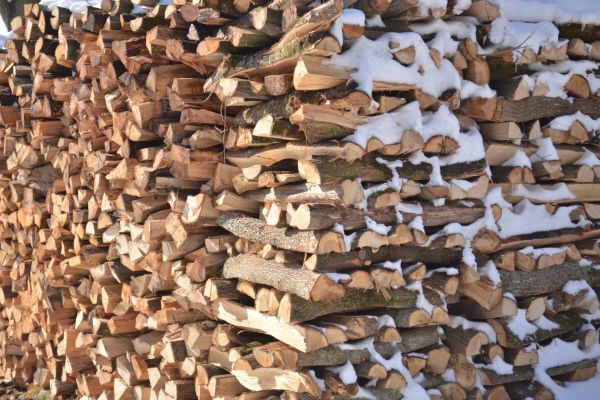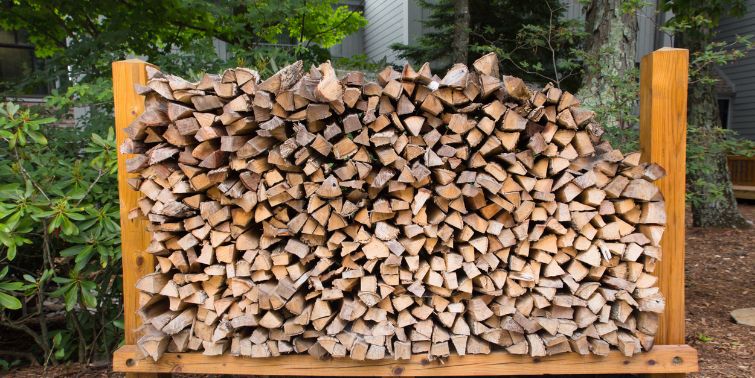Once you buy a bundle of firewood, you can just stack it somewhere and grab it when you need it, right? That’s not exactly the case. While logs do need to be stacked, there is a right way and a whole lot of wrong ways to store your firewood.
If you don’t store your wood correctly based on the season and climate, you might find that your logs are damp or rotted next time you grab a few to toss on the fire.
How do you store firewood the right way? Here’s everything you need to know.
Why Proper Firewood Storage Matters
You want your firewood to burn efficiently. To achieve this, you need firewood that has been properly seasoned or dried. Proper methods of how to store firewood help keep your logs away from pests and moisture. It will be dry and ready to light.
On the other hand, wet firewood produces excess smoke. If you are burning it in your fireplace, that extra smoke will cause creosote buildup in your chimney. Excessive buildup can be dangerous.
Even if you plan on using your logs outdoors, you still need to be concerned about firewood storage. Placing logs on the ground exposes them to termites and other pests. Your wood may also grow mold or start to rot. Either way, it will drastically impact the quality of your fire, if you can get it to burn at all.
The bottom line is that you need to know how to store firewood in all seasons and climates. With that in mind, here are some tips for keeping your logs dry and away from pests in different seasons and environments.
How to Store Firewood Outdoors
Chances are that you will store your firewood outdoors. This is the most convenient option for most people.
If you are using this approach, make sure you keep your logs off the ground to prevent moisture absorption. Your firewood doesn’t have to be high off the ground. You simply need a small barrier. You can use pallets, 2x4s, or concrete slabs as a base. Pavers will work, too.
Getting your logs off the ground promotes better airflow and reduces the risk of mold. Make sure you stack your wood at least 20 feet from your home. You don’t want pests like termites entering.
Choosing the right stacking pattern is an important step in learning how to stack wood like a pro.
How to Store Chopped Wood to Dry
If you buy unseasoned or damp firewood, you’ll need to let it dry. Stack it outside and off the ground to minimize moisture exposure. You should also try to place it in an area where the stack will get lots of direct sunlight.
If it’s the rainy season, consider placing your firewood under an overhang that minimizes rain exposure while still allowing it to get a few hours of sunlight at some point during the day.
How to Store Firewood Indoors
Indoor storage is a good option if you have a small quantity of seasoned or kiln-dried wood. Just be careful about bringing pests inside. If your wood is pre-bundled or wrapped, you should remove any wrapping so you can separate the logs and shake out any debris.
Next, store your wood in a dry, low-humidity room with good airflow. Use a small rack to keep wood off the floor. Don’t keep the wood indoors long-term. If you aren’t going to use it in the next few weeks to a month, you’d be better off placing it in your garage or outside.
How to Store Firewood in Garages
Garages are a good middle ground choice between indoor and outdoor storage. You can keep your logs out of the elements and store larger quantities than you could indoors. Still, you’ll need to use a rack to elevate the wood off the concrete floor.
Regularly inspect your bundle of logs for rodents or insects, as garages attract critters, especially in the cooler months. Keep your stack organized so you can easily access it and still use the rest of your garage.
How to Store Firewood in Spring
Spring brings rain and humidity. You need to protect your firewood from moisture. Use a sturdy tarp to cover the top of your stack. Secure it with bungee cords or counter weights so it doesn’t blow off. Make sure you leave the sides open for air circulation. Place your stack in sunny areas to help it dry out faster after heavy rain.
How to Store Firewood in Summer
Summer heat aids in the drying process, but it can also make your logs too dry. If the moisture content drops too low, the wood will burn fast and produce extra smoke. Make sure you rotate your logs. Use older wood first to avoid rot or excessively low humidity levels.
Additionally, use a breathable cover to shield stacks from occasional rain and avoid stacking against walls or trees, as this traps moisture and attracts insects.
How to Store Firewood in Fall
When fall arrives, check your stack of logs to see if it is properly seasoned. Seasoned wood will show some cracks and feel lighter than moist logs. It also makes a hollow sound when you strike it.
Store your firewood under a tarp or in a covered area to protect it against increasing rain. Position your stacks to avoid water pooling from fall storms. If you live in an excessively humid area, make sure your stack has proper ventilation.
How to Store Firewood in Winter
Now that it’s fireplace season, it’s time to put all of that seasoned wood to use. If you live in an area that receives regular snow and drops below freezing temperatures, you’ll need to take extra steps to keep your wood dry.
Clear snow from the covers regularly and place your logs on an elevated platform to avoid ground moisture. When you start burning, use your oldest wood first.
 Keeping Your Logs Fire-Ready in Different Climates
Keeping Your Logs Fire-Ready in Different Climates
The climate you live in will have a huge impact on the quality of your logs and how you store your firewood. Here are some tips for different environments.
Storing Logs in Dry Climates
Dry climates speed up the seasoning process. You can get moist logs ready to burn in just a few months. There is also a lower risk of mold. However, over-drying is a risk.
Use a moisture meter and aim to keep your logs at around 15% moisture. Anything lower than that will burn too quickly.
In this instance, consider storing your wood in a shaded area. You don’t need to place your logs in direct sunlight if it’s hot and dry outside.
Storing Firewood in Humid Climates
If you live in a humid climate, such as a coastal area, you may have a tough time getting your firewood dry enough. You’ll need extra ventilation to prevent mold. Use a log store with open sides or a tarp covering only the top.
Elevate your stack a little higher than you would in a dry climate. Place the wood in a sunny spot to assist with drying.
You can avoid many of the hassles associated with storing firewood in humid climates by purchasing kiln-dried logs. While these logs must still be kept dry, they are already at optimal moisture levels.
Storing Firewood in Cold Climates
If you live in a cold climate, you don’t have to worry about high humidity levels. However, you do need to safeguard your wood against snow and ice to avoid excess moisture from melting.
How to Keep Firewood Dry
To keep your logs dry, elevate them off the ground. Use a tarp or shed to cover the top only, allowing air circulation. If you live in a wet climate, always check your covers after any heavy rain or storms to ensure they’re secure.
Common Firewood Storage Mistakes
Here are some mistakes that could keep you from enjoying a blazing hot fire this winter season:
- Stacking wood directly on the ground
- Covering the entire stack, which traps moisture
- Tightly stacking or bundling your logs
- Failing to use the oldest wood first
- Keeping wood too close to your home
One of the biggest mistakes involves buying poor-quality or wet logs. If your firewood hasn’t been seasoned, you’ll need to let it dry for weeks or months. You can’t expect to have a roaring fire immediately with damp wood.
Fortunately, you can avoid this headache by purchasing kiln-dried firewood. This wood has been reduced to extremely low moisture levels, meaning it will light more easily and burn cleaner.
Need High Quality Logs for Your Fire? ProCut Firewood Has Got You Covered
Don’t settle for soggy logs or poor-quality firewood. ProCut Firewood has a premium selection of kiln-dried bundles that burn clean. Contact ProCut Firewood and place your order today.







